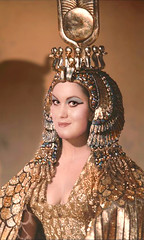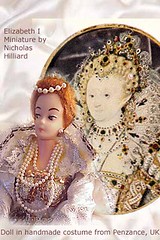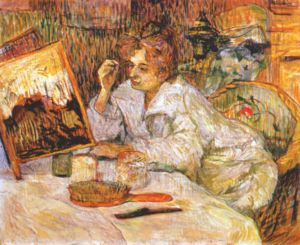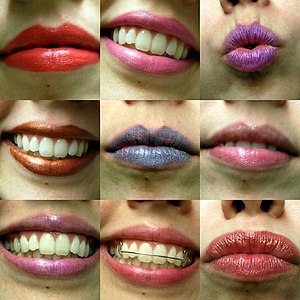The History of Lipstick - Use in Ancient and Victorian Times
 Image by mnadi via Flickr
Image by mnadi via Flickr
Lipstick usage then reached the Egyptian empire, where it primarily denoted social status rather than gender. Egyptian men and women boldly applied makeup as part of their daily routine. Eyes had the most cultural importance, and so garnered the most attention, but lips too received color from red ochre, either applied alone or mixed with resin or gum for more lasting finish. Other popular color choices included orange, magenta, and blue-black.
Early in the Greek empire, most women eschewed all facial makeup. Lip paint became largely the domain of prostitutes, and under Greek law, prostitutes who appeared in public without their designated lip paint were punished for improperly posing as ladies.
At some point between 700 and 300 B.C., lip color seeped into Classical Greece’s mainstream culture. A couple of centuries later in Germany and Britain, orange lip color became widely popular.
However in the middle ages religious criticism of lipstick finally gained widespread hold in some countries. In England, “a woman who wore make-up was seen as an incarnation of Satan,” because such alteration of her given face challenged God and his workmanship.
Even in England, however, the social prohibition on lip coloring had its exceptions. Applying a lily or rose tint to one’s lips remained permissible based on those colors’ connotation with purity. Thus, many women would fashion rose lip rouge of sheep fat and mashed up red roots. Other countries & cultures never so fully accepted the idea the piety prohibited lipstick. During the 1200’s A.D. in present-day Italy, lipstick remained an important tool for social demarcation, with high society ladies wearing bright pink lip rouge and lower class women wearing earthy red lip rouge.
 Image by mharrsch via Flickr
Image by mharrsch via Flickr
A lip rouge devotee, Queen Elizabeth usually made her own crimson color with a combination of cochineal, gum Arabic, egg whites, and fig milk. Elizabeth or one of her close associates also appears to have invented the lip pencil, which was made by mixing ground alabaster or plaster of Paris with a coloring ingredient, rolling the resultant paste into a crayon shape, and drying it in the sun.
On one hand, the English loved lipstick to the point that it not infrequently served as a cash substitute while on the other hand the religious clergy associated its use with blasphemy.
A substantial part of lipstick’s popularity though, came from the belief that it could work magic, possibly even ward off death. Modern minds might find this faith in lipstick’s health benefits ironic given that ceruse served as a main ingredient in most lip rouges and salves of the period, but few Elizabethans questioned their lip rouge’s power. The queen herself credited lipstick with lifesaving powers, and so, when she fell ill, applied lip rouge increasingly heavily. By her death, Elizabeth had on nearly a half-inch of lip rouge. But, this belief in lipstick’s magical force caused the cosmetic to provoke the wrath of church. Pictures of devils putting lipstick on women appeared often, and women frequently had to address their lipstick use at confession in witch-trials.
The 1600s A.D. presented more of the same: a continued siege on lipstick from clergy, ethicists, and occasionally lawmakers, and a continued love affair with lipstick by the English population. During James I’s reign in the early part of the century, lip rouge remained evident but relatively discrete among both upper and lower classes. As so often before, the classes wore different colors of lipstick. This time though, the color distinction was principally, if not solely, based on cost of ingredients. The upper class indulged in a bright cherry red while the lower class stuck with the cheaper ochre red. The upper class also enjoyed safer lip rouge made with animal fat imported from France, while the lower class continued wearing lip rouge made of the much cheaper ceruse. Even male courtiers employed lip rouge, but, because lipstick remained very much identified with femininity, they also tried to disguise this practice.
This female discretion and male secrecy vanished upon the establishment of Charles II’s court. Ladies painted freely, favoring full red lips modeled after previous years’ theatrical makeup. Gentlemen also openly began wearing lip rouge. Since lip and check rouge had yet to include fixatives, this rampant use proved quite messy.
Although Parliament’s res orts at ridding the public of lipstick failed in the short term, England did veer away from lipstick in the long run. By the 1700s, wearing lipstick had returned to a surreptitious practice in Englan
 Image by Gauis Caecilius via Flickr
Image by Gauis Caecilius via Flickr
Of course, some women did not bother with such elaborate concoctions, and simply applied brandy to their lips until they turned red. This reserving of lip rouge for the older, and so presumably married, women moved from social convention to severe black letter law in 1770 when the Parliament declared that women who seduced men into matrimony through use of lip and cheek paints couldhave their marriages annulled as well as face witchcraft charges.
American women achieved reddened lips by most means imaginable, from rubbing red snippets of ribbon across their mouths, to carrying around lemons for sucking on throughout the day, to purchasing Spanish Papers. Red Liquor also promised American women red lips, whether rubbed on or drunk. Even Martha Washington had a favorite recipe for lip rouge, which involved: wax, hogs’ lard, spermaceti, alkanet root, almond oil, balsam, raisins, and sugar.
As the Victorian Age dawned, Queen Victoria publicly declared makeup “impolite,” and makeup became socially unacceptable for all but prostitutes and actresses. Lipstick, in particular, remained the least respectable of cosmetics throughout the century. Of course, with lipstick, “going out of fashion simply meant going underground.” Women developed a range of strategies for dodging the social prohibition on lip rouge.
 Image via Wikipedia
Image via Wikipedia
Many women turned to non-cosmetic methods, such as kissing rosy crepe paper or biting their lips to attain a red color and doing lip calisthenics to achieve the idealized bee-stung shape. Many others turned to all manner of subterfuges. Lip salves used with the excuse of moistening chapped lips actually “cunningly concealed a touch of carmine.” Lip rouges also masqueraded as medicine, with the medicine makeup quack finding a new source of income on the edge of the medical profession.
Clandestine beauty establishments at which one could buy lip rouge survived based on discretion; women would arrive veiled, get ushered into individual private rooms, and then smuggle their purchases back home for hiding. All of this furtively continued use of lip rouge eventually started to seep out into the open towards the very end of the century.
This relaxation in social lipstick restrictions most often gets credited to actresses who made it into society while continuing to wear the makeup that they used on stage. Continued unabashed use of makeup by high-end prostitutes also likely contributed to lipstick’s eventual resurfacing.
Additionally, more cynical scholars propose that lip rouge application became allowable largely because men found it newly wise permit such application. According to this theory, men began to quietly encourage cosmetics use in the hopes that a concern for makeup would in turn discourage the even greater evil of female spo
 Image via Wikipedia
Image via Wikipedia
At the turn of the twentieth century, lipstick began to acquire the symbolic and economic standing that it holds today, with rapidly increasing numbers of women using the product impervious to its lack of safety. Lipstick continued to symbolize femininity as it continuously had done for four hundred years prior, but now this symbolism contained a twist. Due to the endorsement of leading su ragettes, lipstick more specifically symbolized female emancipation. Lipstick’s long proscription by social, religious, and legal male authority made it a ready symbol for female rebellion.
What does the Lipstick mean to you? Is it just a colored tube of wax for your lips or does it have deeper resonance in your life?
![Reblog this post [with Zemanta]](http://img.zemanta.com/reblog_a.png?x-id=f57c9fa5-6031-4cde-be15-54c2ae43ebff)


I know.. most of us treat lipstick as a cheer-me-up kind of product.. Until i researched for it even i didn't know what a history it had.. frm bring banned & all..
ReplyDeleteAt yr age even i preferred pink shades coz red ones make u look very grown up, but over time u too will be able to carry such shades..
just bounced on this topic, my my wat a research, tanvi :) simply superb
ReplyDelete@ Thks Divs!! :D
ReplyDeleteFun to know the history behind lipstick! I will continue to wear my red lipstick proudly💖
ReplyDelete